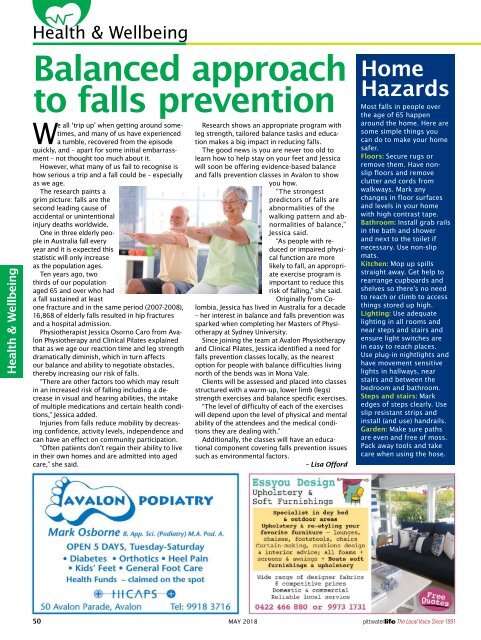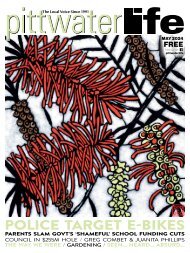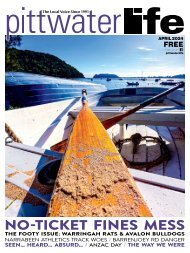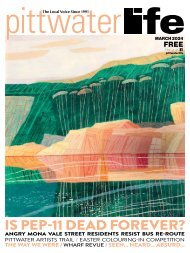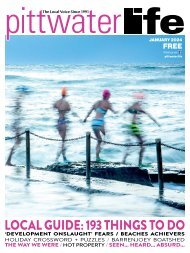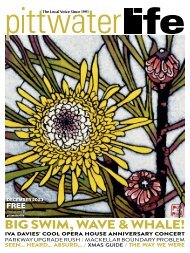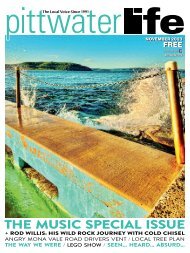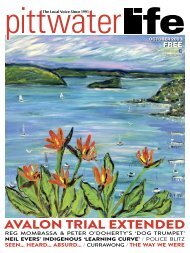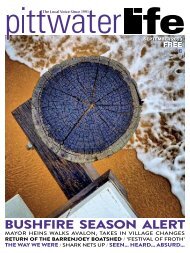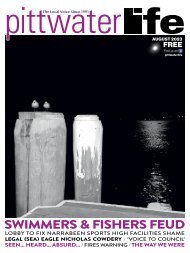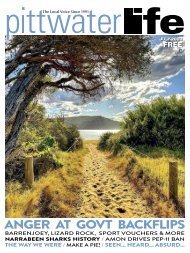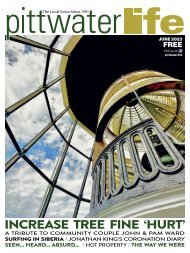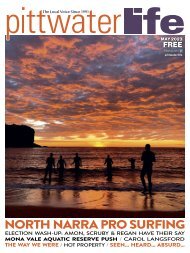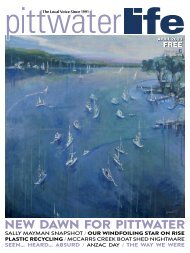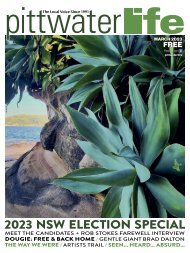Pittwater Life May 2018 Issue
Care Factor - Meet the Hospital's New 'Urgency Team'. Good Sport. Minding Own Business. University of Warriewood?
Care Factor - Meet the Hospital's New 'Urgency Team'. Good Sport. Minding Own Business. University of Warriewood?
Create successful ePaper yourself
Turn your PDF publications into a flip-book with our unique Google optimized e-Paper software.
Health & Wellbeing<br />
Health & Wellbeing<br />
Balanced approach<br />
to falls prevention<br />
We all ‘trip up’ when getting around sometimes,<br />
and many of us have experienced<br />
a tumble, recovered from the episode<br />
quickly, and – apart for some initial embarrassment<br />
– not thought too much about it.<br />
However, what many of us fail to recognise is<br />
how serious a trip and a fall could be – especially<br />
as we age.<br />
The research paints a<br />
grim picture: falls are the<br />
second leading cause of<br />
accidental or unintentional<br />
injury deaths worldwide.<br />
One in three elderly people<br />
in Australia fall every<br />
year and it is expected this<br />
statistic will only increase<br />
as the population ages.<br />
Ten years ago, two<br />
thirds of our population<br />
aged 65 and over who had<br />
a fall sustained at least<br />
one fracture and in the same period (2007-2008),<br />
16,868 of elderly falls resulted in hip fractures<br />
and a hospital admission.<br />
Physiotherapist Jessica Osorno Caro from Avalon<br />
Physiotherapy and Clinical Pilates explained<br />
that as we age our reaction time and leg strength<br />
dramatically diminish, which in turn affects<br />
our balance and ability to negotiate obstacles,<br />
thereby increasing our risk of falls.<br />
“There are other factors too which may result<br />
in an increased risk of falling including a decrease<br />
in visual and hearing abilities, the intake<br />
of multiple medications and certain health conditions,”<br />
Jessica added.<br />
Injuries from falls reduce mobility by decreasing<br />
confidence, activity levels, independence and<br />
can have an effect on community participation.<br />
“Often patients don’t regain their ability to live<br />
in their own homes and are admitted into aged<br />
care,” she said.<br />
Research shows an appropriate program with<br />
leg strength, tailored balance tasks and education<br />
makes a big impact in reducing falls.<br />
The good news is you are never too old to<br />
learn how to help stay on your feet and Jessica<br />
will soon be offering evidence-based balance<br />
and falls prevention classes in Avalon to show<br />
you how.<br />
“The strongest<br />
predictors of falls are<br />
abnormalities of the<br />
walking pattern and abnormalities<br />
of balance,”<br />
Jessica said.<br />
“As people with reduced<br />
or impaired physical<br />
function are more<br />
likely to fall, an appropriate<br />
exercise program is<br />
important to reduce this<br />
risk of falling,” she said.<br />
Originally from Colombia,<br />
Jessica has lived in Australia for a decade<br />
– her interest in balance and falls prevention was<br />
sparked when completing her Masters of Physiotherapy<br />
at Sydney University.<br />
Since joining the team at Avalon Physiotherapy<br />
and Clinical Pilates, Jessica identified a need for<br />
falls prevention classes locally, as the nearest<br />
option for people with balance difficulties living<br />
north of the bends was in Mona Vale.<br />
Clients will be assessed and placed into classes<br />
structured with a warm-up, lower limb (legs)<br />
strength exercises and balance specific exercises.<br />
“The level of difficulty of each of the exercises<br />
will depend upon the level of physical and mental<br />
ability of the attendees and the medical conditions<br />
they are dealing with.”<br />
Additionally, the classes will have an educational<br />
component covering falls prevention issues<br />
such as environmental factors.<br />
– Lisa Offord<br />
Home<br />
Hazards<br />
Most falls in people over<br />
the age of 65 happen<br />
around the home. Here are<br />
some simple things you<br />
can do to make your home<br />
safer.<br />
Floors: Secure rugs or<br />
remove them. Have nonslip<br />
floors and remove<br />
clutter and cords from<br />
walkways. Mark any<br />
changes in floor surfaces<br />
and levels in your home<br />
with high contrast tape.<br />
Bathroom: Install grab rails<br />
in the bath and shower<br />
and next to the toilet if<br />
necessary. Use non-slip<br />
mats.<br />
Kitchen: Mop up spills<br />
straight away. Get help to<br />
rearrange cupboards and<br />
shelves so there’s no need<br />
to reach or climb to access<br />
things stored up high.<br />
Lighting: Use adequate<br />
lighting in all rooms and<br />
near steps and stairs and<br />
ensure light switches are<br />
in easy to reach places.<br />
Use plug-in nightlights and<br />
have movement sensitive<br />
lights in hallways, near<br />
stairs and between the<br />
bedroom and bathroom.<br />
Steps and stairs: Mark<br />
edges of steps clearly. Use<br />
slip resistant strips and<br />
install (and use) handrails.<br />
Garden: Make sure paths<br />
are even and free of moss.<br />
Pack away tools and take<br />
care when using the hose.<br />
50 MAY <strong>2018</strong><br />
The Local Voice Since 1991


